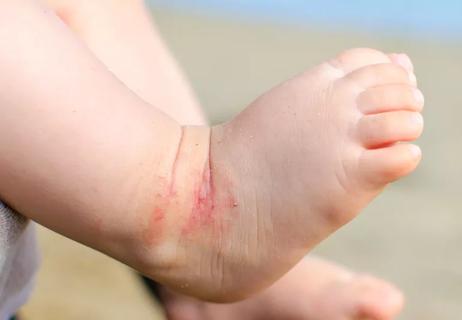Advertisement
A sunken soft spot may be a sign of dehydration, while a bulging soft spot may be a sign of head trauma

When you’re a new parent, you know that your baby needs you for a lot of things. From help burping and safe sleep practices to proper feeding, your baby relies on you to learn their cues and keep them safe and healthy.
Advertisement
Cleveland Clinic is a non-profit academic medical center. Advertising on our site helps support our mission. We do not endorse non-Cleveland Clinic products or services. Policy
So, when you realize that your itty-bitty bundle of joy has bones in their noggin that aren’t entirely fused together, it’s natural to wonder if those soft spots — also called fontanelles — are as they should be.
In truth, your baby’s fontanelles rarely require much attention. But they’re an important reminder of just how fragile your infant is.
That’s why, if something changes — like the fontanelle looks sunken or bulging — you may worry there’s something wrong.
A change in the fontanelle isn’t always a major problem, but it can sometimes reveal areas for concern, says pediatrician Brigitta Moresea, MD. “Your baby’s soft spots are a good indicator of the baby’s potential hydration status and brain status. They’re like automatic pressure sensors.”
What exactly are fontanelles? And what do you need to know about them? Dr. Moresea explains and shares advice.
When babies are born, their skulls aren’t fully formed. That’s normal. And it’s like that for a reason.
“Babies’ heads aren’t entirely fused together,” Dr. Moresea explains. “That’s what allows the baby’s head to travel more easily through the birth canal. It also allows for rapid head growth during the first year of their life.”
The fontanelles are the diamond-shaped soft spots in between baby’s skull plates that haven’t yet joined together. These soft spots are covered in skin and protected by a layer of tough membranes. So, even though they’re called “soft spots” they’re still pretty hardy. As long as you’re using normal and cautious baby care and baby handling practices, you’re not going to hurt them.
Advertisement
There are two main fontanelles.
The anterior fontanelle is right on top of your baby’s head. It’s the one you most typically think of when you hear about “baby’s soft spot.” On average, it’s about 2.1 centimeters (cm) in diameter. That’s about the size of a penny. The anterior fontanelle typically closes soon after your child’s first birthday.
The posterior fontanelle is smaller and is on the back of baby’s head. The average size of the posterior fontanelle is about the size of a pencil eraser (0.5 cm in diameter). It typically closes by the time your baby is just 2 or 3 months old.
Sometimes, a baby’s fontanelle can be a window into potential concerns with their growth and development.
Checking baby’s fontanelle is a regular part of visits with a pediatric healthcare provider, like during well-child checkups. Your baby’s provider may measure their head and lightly feel their fontanelles as part of their standard exam.
If you or a healthcare provider notice a change in your baby’s fontanelles, it’s worth paying attention.
Dr. Moresea explains some common changes in the fontanelle and what they may be telling you about your infant’s health.
A baby’s soft spot should be mostly flush with the rest of their noggin. So, if it divots in like the top of a golf tee, it may be cause for concern.
“A sunken fontanelle is often a sign of dehydration,” Dr. Moresea states. “It may occur if your child is sick and not getting enough fluids.”
Other signs that your baby may be dehydrated include:
What to do about a sunken fontanelle: Encourage your baby to drink more by offering extra bottles or breastfeeding sessions. See your child’s healthcare provider, like their pediatrician, if the sunken appearance persists and you can’t get your baby to take in more fluids. Also contact your provider if your child is showing other signs of illness, like a worrying fever.
If your baby’s fontanelle is bulging or looks swollen, it may be cause for concern.
For example, after a fall, a swollen soft spot is sometimes a sign of head trauma. It may also be accompanied by vomiting.
If your baby’s fontanelle is bulging and there’s no reason to think they’ve recently hit their head, there may be other reasons to seek medical care.
A bulging fontanelle can be a sign of viral or bacterial infection.
In rarer cases, bulging can be a result of fluid buildup in the brain — a condition called hydrocephalus. It can cause rapid head growth and make the soft spot look “full,” Dr. Moresea says. A bulging fontanelle may also stem from conditions like internal bleeding or a tumor or mass causing pressure in the head.
Advertisement
What to do about a bulging fontanelle: If your child’s soft spot is swollen, Dr. Moresea advises contacting your child’s healthcare provider. If the bulging is the result of an injury to your baby’s head, seek prompt medical attention, such as your local emergency room. Also seek emergency attention if a bulging fontanelle comes with symptoms like fatigue, vomiting or changes in your baby’s temperament — like if they’re extra sleepy or fussy.
In most babies, soft spots are pretty obvious. You can feel them with your hand using very gentle pressure. You may even feel their pulse when you feel their fontanelles.
But what do you do if you can’t feel your baby’s fontanelle? Can the soft spot close up too quickly?
Some babies have what Dr. Moresea calls a “quiet fontanelle.” That’s to say, a soft spot that’s less noticeable.
As long as your child’s head is growing normally, there’s not much to worry about if your baby’s soft spot is less pronounced.
But if their healthcare provider is concerned that your baby’s soft spot has closed too soon, they may suggest an imaging test to make sure.
“Occasionally, the skull bones do close earlier than normal on one side. That causes a condition called craniosynostosis,” Dr. Moresea explains. “Depending on which bones fused, baby may develop an asymmetric or ‘abnormal’ head shape. For example, sagittal craniosynostosis, the most common form, results in a longer head that is shaped somewhat like a football.”
Advertisement
What you should do: Talk with your child’s healthcare provider if you believe their soft spot is closed prematurely. Children with craniosynostosis may need to wear a specialized medical helmet to help reshape their skull. Some babies may also need surgery to open the fused bones and reshape their skull.
Soft spots that are bigger than average or stay open longer than about a year can sometimes be a sign of a medical condition.
Researchers say that large fontanelles and fontanelles that don’t close when they’re expected to can be associated with conditions like:
It’s important to note that these conditions come with other symptoms. No need to prematurely rush to conclusions if your baby is otherwise developing normally.
What you should do: Talk to your child’s healthcare provider about the development of their fontanelle and any other concerns you have about your baby’s growth and development.
Your baby’s soft spot can be an indication of their overall health. But it’s just one way to assess whether your child is growing as expected.
Advertisement
Talk with your healthcare provider if you have any questions or concerns. Keep up with regular well-child checkups to make sure your little one is on track for healthy development.
Learn more about our editorial process.
Advertisement

‘Social smiles’ typically start around 8 weeks old, while laughter comes later — around 4 to 6 months

Most infants can roll from tummy to back by 6 months old — but remember, every child develops at their own pace

Too much time in certain infant ‘containers’ can cause developmental delays and a flat spot on baby’s head

Keeping their skin moisturized — and scratching at bay — is half the battle

Your baby’s skin is more sensitive, so keep the tub water under 100 degrees Fahrenheit

Delays in growth, stomach aches and bathroom issues are all symptoms of this serious digestive condition

Current research suggests 1 of every 31 children in the U.S. has ASD — and that’s probably an undercount

Tiny taste-testing is a way babies can explore their world, relieve aching gums and self-soothe

If you’re feeling short of breath, sleep can be tough — propping yourself up or sleeping on your side may help

If you fear the unknown or find yourself needing reassurance often, you may identify with this attachment style

If you’re looking to boost your gut health, it’s better to get fiber from whole foods